- by New Deal democrat
Yesterday’s JOLTS report for September showed a jobs market that continues to be, ever so slowly, on the mend. Openings and quits were up (good), and layoffs and discharges were down (also good). The only negative was that hires actually declined, although slightly.
We are far enough past the worst of the pandemic jobs losses that it is worthwhile to compare the state of the various JOLTS components with the 2 previous recoveries from recession bottoms in the series’ histories (this because the JOLTS data only dates from 2001.
In the two past recoveries:
Let’s examine each of those in turn. In each case, I break out 2001-19 in a first graph and then this year in a second.
We are far enough past the worst of the pandemic jobs losses that it is worthwhile to compare the state of the various JOLTS components with the 2 previous recoveries from recession bottoms in the series’ histories (this because the JOLTS data only dates from 2001.
In the two past recoveries:
- first, layoffs declined
- second, hiring rose
- third, job openings rose and voluntary quits increased, close to simultaneously
Let’s examine each of those in turn. In each case, I break out 2001-19 in a first graph and then this year in a second.
What appears below is that, although there has been some variation, the past several months have recapitulated the pattern from the last two early recoveries: the first two data series to turn - layoffs and hires - have indeed turned, while the last two - job openings and voluntary quits - have appeared to bottom but have had a much less dramatic rise.
This first graph compares layoffs and discharges (blue) with the 4 week average of initial jobless claims (red):
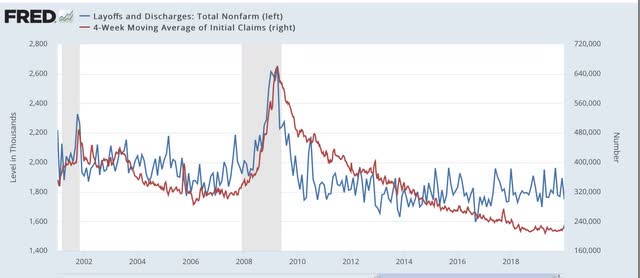
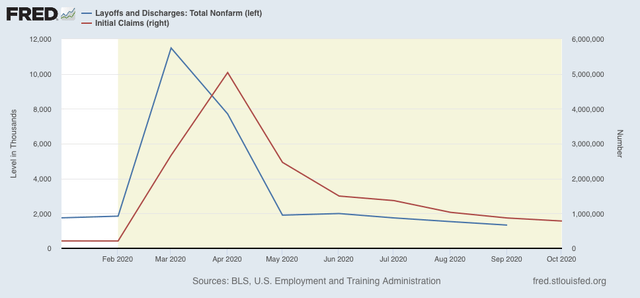
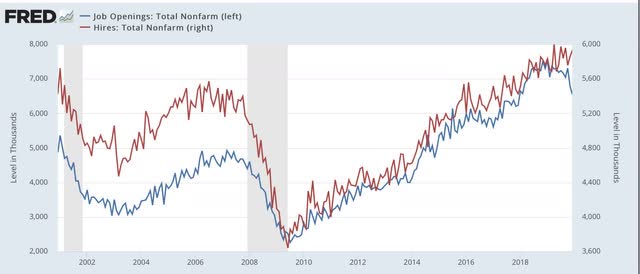
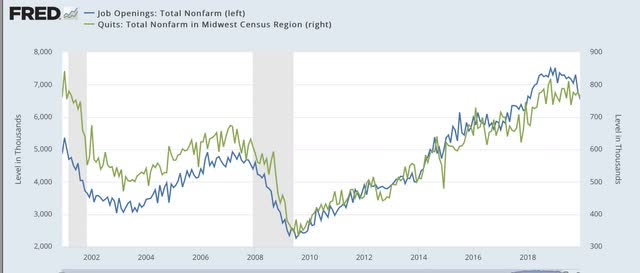
In the past two recoveries, actual hiring started to rise slightly before quits made a bottom. After that, both rose more or less together (suggesting it is openings that leads to the increase in voluntary quits).
This year, both have moved together, both making a trough in April, and rising equivalently since:
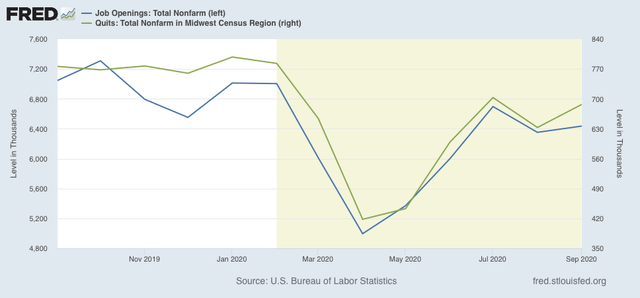
Finally, because seasonal adjustments might not be giving us a true picture because of the enormous moves during this pandemic year, here are job openings (blue), hires (red), and voluntary quits (green), measured YoY without seasonal adjustments for the recoveries after the 2001 and 2007-09 recessions:
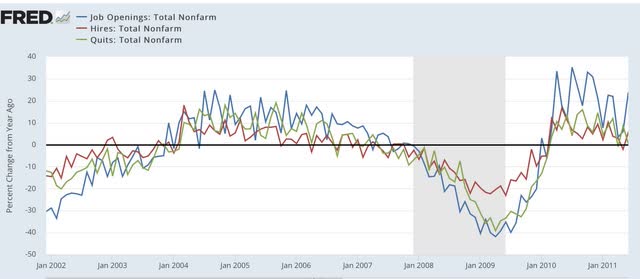

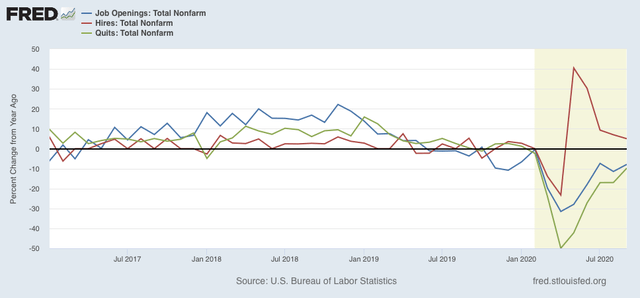
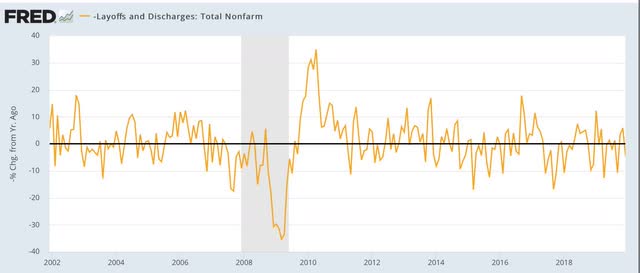
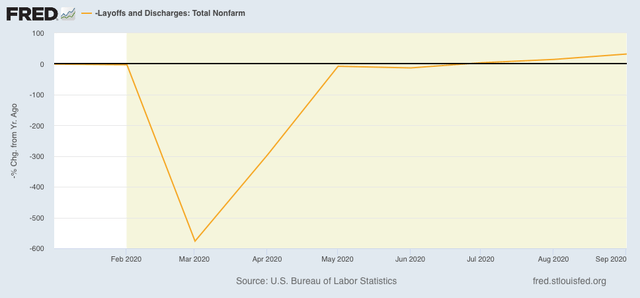
In short, the JOLTS report shows that the recovery in the jobs market from the pandemic lows is real, and as of September was continuing.
This first graph compares layoffs and discharges (blue) with the 4 week average of initial jobless claims (red):

You can see that, by the end of the recessions, layoffs were already declining, and continued to decline steeply over the next 3-8 months before reaching a “normal” expansion level. The turning point coincides exactly with the much less volatile, but more slowly declining, level of initial jobless claims.
The same has been the case this year, as layoffs and discharges already declined to their “normal” level in May, while initial jobless claims peaked one to two months later, and have been declining (slowly) ever since - a pattern that continued in September.
Next, here are hires (red) and job openings (blue):
The same has been the case this year, as layoffs and discharges already declined to their “normal” level in May, while initial jobless claims peaked one to two months later, and have been declining (slowly) ever since - a pattern that continued in September.
Next, here are hires (red) and job openings (blue):

In the past two recoveries, actual hires started to increase one to two months before job openings.
This year, both made troughs in April, but hires rebounded sharply in May and June compared with job openings:
This year, both made troughs in April, but hires rebounded sharply in May and June compared with job openings:

Since then both have essentially leveled off.

Next, here are quits (green) vs. job openings (blue):

Next, here are quits (green) vs. job openings (blue):

In the past two recoveries, actual hiring started to rise slightly before quits made a bottom. After that, both rose more or less together (suggesting it is openings that leads to the increase in voluntary quits).
This year, both have moved together, both making a trough in April, and rising equivalently since:

Finally, because seasonal adjustments might not be giving us a true picture because of the enormous moves during this pandemic year, here are job openings (blue), hires (red), and voluntary quits (green), measured YoY without seasonal adjustments for the recoveries after the 2001 and 2007-09 recessions:


Nte that, even taking out the seasonal adjustments, hires rebounded first following the 2001 and 2008-09 recessions. Quits and openings have moved generally in tandem with a slight lag.
The same pattern appears this year:

I have broken out layoffs and discharges separately below, because the their level in April and May of this year would obliterate all other variations (note: inverted so that fewer layoffs shows as positive):


This metric returned to normal almost immediately after both of the past two recessions, and did so again by July of this year, and is improving slightly measured YoY.
In short, the JOLTS report shows that the recovery in the jobs market from the pandemic lows is real, and as of September was continuing.
With the pandemic largely once again out of control, and approaching emergency levels in many parts of the country, it is an open question to say the least whether this will continue. I have to think that responsible State governments are going to reinstitute lockdowns for at least long enough to bring the pandemic back under some semblance of control.